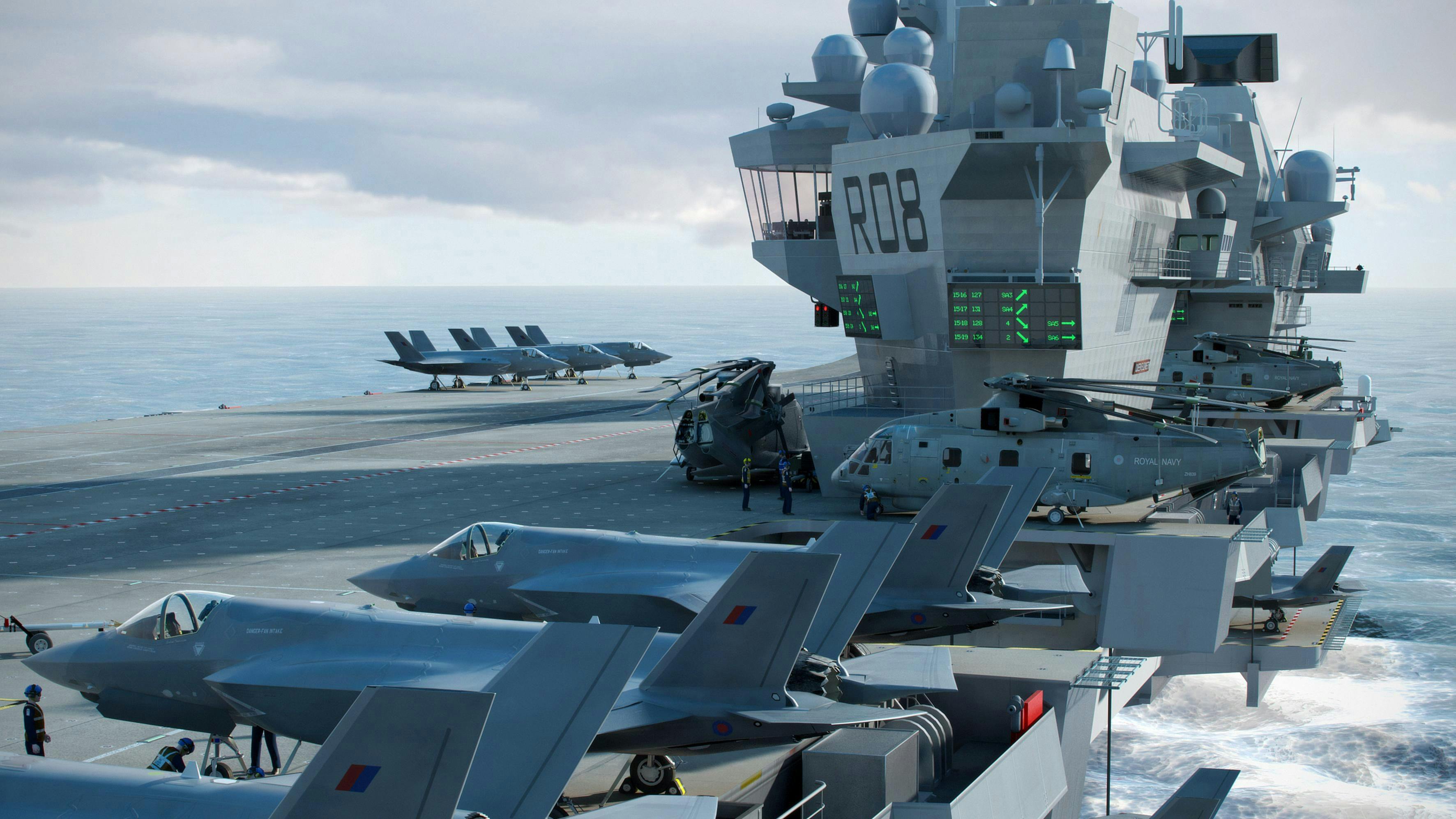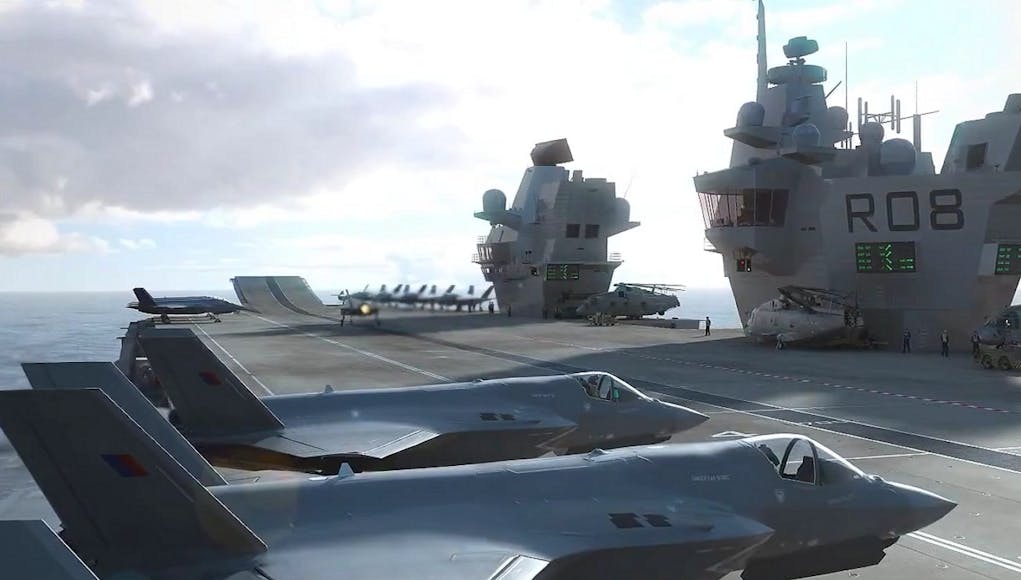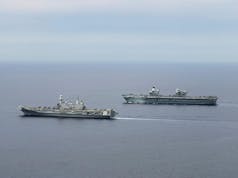It has been revealed that the first of the two new Queen Elizabeth carriers will conduct F-35 flight trials off the eastern coast of the US in 2018.
HMS Queen Elizabeth is expected to start fixed-wing flight trials with three or more British F-35Bs off the eastern coast of the US towards the end of the summer of 2018.
Ian Booth, managing director of the Aircraft Carrier Alliance said:
“Pretty much everything is now installed in the ship and working. We’ve had lots of prior factory testing before putting systems on board and so far, it’s all looking pretty good.
Over the next few months we will finish compartment handovers, and complete work to coat the flight deck. We will also conduct harbour events and acceptance trials for virtually all systems – propulsion, steering, navigation, or communications – here [at Rosyth] before we go.”
F-35 pilots also embarked on the USS America week for at-sea developmental testing phase 3 (DT3), the last trial that paves the way for the US Marine Corps to deploy the jet operationally on amphibious assault ships.
BAE Systems test pilot Pete Wilson said:
“This will not be a DT phase. Testing on the Queen Elizabeth will be like DTs 1, 2 and 3 combined.
We don’t need to use fully instrumented aircraft; we already understand most of the loads on the aircraft systems, as we have tested that during earlier tests.”
What will the vessels carry?
The term now used for the carriers embarked squadrons is ‘Carrier Air Wing’ (CVW). The vessels are capable of deploying a variety of aircraft in large numbers, up to a maximum in the upper fifties in surge conditions.

Captain Jerry Kyd, commander of HMS Queen Elizabeth, commented on the initial deployment and the gradual increase in air wing numbers:
“We are constrained by the F-35 buy rate even though that was accelerated in SDSR in 2015, so initial operating capability numbers in 2020 are going to be very modest indeed.
We will flesh it out with helicopters, and a lot depends on how many USMC F-35s come on our first deployment in 2021. But by 2023, we are committed to 24 UK jets onboard, and after that it’s too far away to say.”
In addition to the joint force of Royal Air Force and Royal Navy F-35Bs and their pilots, the air wing is expected to be composed of a ‘Maritime Force Protection’ package of nine anti-submarine Merlin HM2 and four or five Merlin for airborne early warning; alternatively a ‘Littoral Manoeuvre’ package could include a mix of RAF Chinooks, Army Apaches, Merlin HC4 and Wildcat HM2. We understand that vessel would still carry at least one F-35 squadron aboard in such circumstances to offer air defence as well as support to the helicopter assault activities.
The Crowsnest AEW&C aircraft will come from a number of the embarked Merlins (any of which can be fitted with the sensor package), the number again scaling with requirements.
Around the time the first carrier deploys operationally, the UK will have 42 F-35 aircraft, with 24 being front-line fighters and the remaining 18 will be used for training (at least 5 on the OCU), be in reserve or in maintenance.
Recently, the Ministry of Defence confirmed plans for the deployment of American F-35 aircraft alongside British jets aboard HMS Queen Elizabeth.
The addition of US Marine Corps aircraft will see HMS Queen Elizabeth sail with 24 or so F-35Bs in addition to around 14 or so helicopters for her maiden deployment. It is understood that the US aircraft will augment British jets on coalition operations.
We understand that the composition of the CVW is a balance between ship capacity and squadron availability. Squadrons assigned or ‘programmed’ to sail on deployment will mostly in the case of the aircraft carrier be unique to it, for example the airborne early warning helicopters that have no other purpose but to serve the carrier force.
In addition, we have also been told by a senior source that we will shortly see decisions like this for the F-35B and “maybe a utility helicopter (or tilt-rotor in future) type”.
The source we spoke to told us that his expectation is that the vessels will sail with a larger number of F-35 than previously expected because “It is not that they can’t do land based operations, just that there is a need to get the return on investment for the well found forward deployed bases that these aircraft carriers that form the centre of the CSG are” and that “the capacity of the F-35B force in the near years in particular is very limited and it is unwise to do other deployments”.
We discussed this with retired Air Marshal Greg Bagwell who expressed doubt that the composition of the CVW would develop this way initially, referring to the idea of set numbers being assigned so far in advance he said:
“There is absolutely no need to fix a flexible capability so far in advance – it hems politicians in unnecessarily.”
Another source we spoke to, currently flying the jet, explained to us that the vessels will deploy with the number and type of aircraft required for a specific deployments:
“Where F-35B is based is entirely down to the most suitable basing option for the tasks/missions is being sent to do. If that’s a well-founded host nation base, great; if it’s the Carrier, great; if it’s an austere location, fine.
Range, logistics and other ‘enablers’ such as AAR and connectivity will determine what’s the best option.”
The Queen Elizabeth class mark a change from expressing carrier power in terms of number of aircraft carried, to the number of sortie’s that can be generated from the deck. The class are not the largest class of carrier in the world but they are most likely the smallest and least expensive carrier the Royal Navy could build which still have the advantages that large carriers offer.
The flight trials are expected to take several months. HMS Queen Elizabeth is planned to sail in March 2017 for 11 weeks of builders sea trials in the North Sea.














I wonder how they test the coating in preparation for 2018 flight tests. Have they taken some sort of mega-heater or flame thrower or even an engine on board and blasted the coated deck to check it doesn’t blister or buckle? Maybe that’s been one of the things going on underneath the tents. If not then we’ll need to wait until 2018 to be sure the coating has bonded to the deck as expected in terms of thermal properties.
They tested F35b on replica ski-jumps in the USA last year. Presumably using the same coatings.
PURELY out of academic interest (no whining about not understanding UK requirements, which is the best naval jet, etc please)….
Could the QE-class be retro-fitted with cats (steam or electro-mags) and traps later? Or has the possibility been designed out?
[…] that the new Elizabeth-class aircraft carriers will come into service without aircraft – see HERE, and HERE. [Click on image to link to the […]